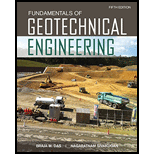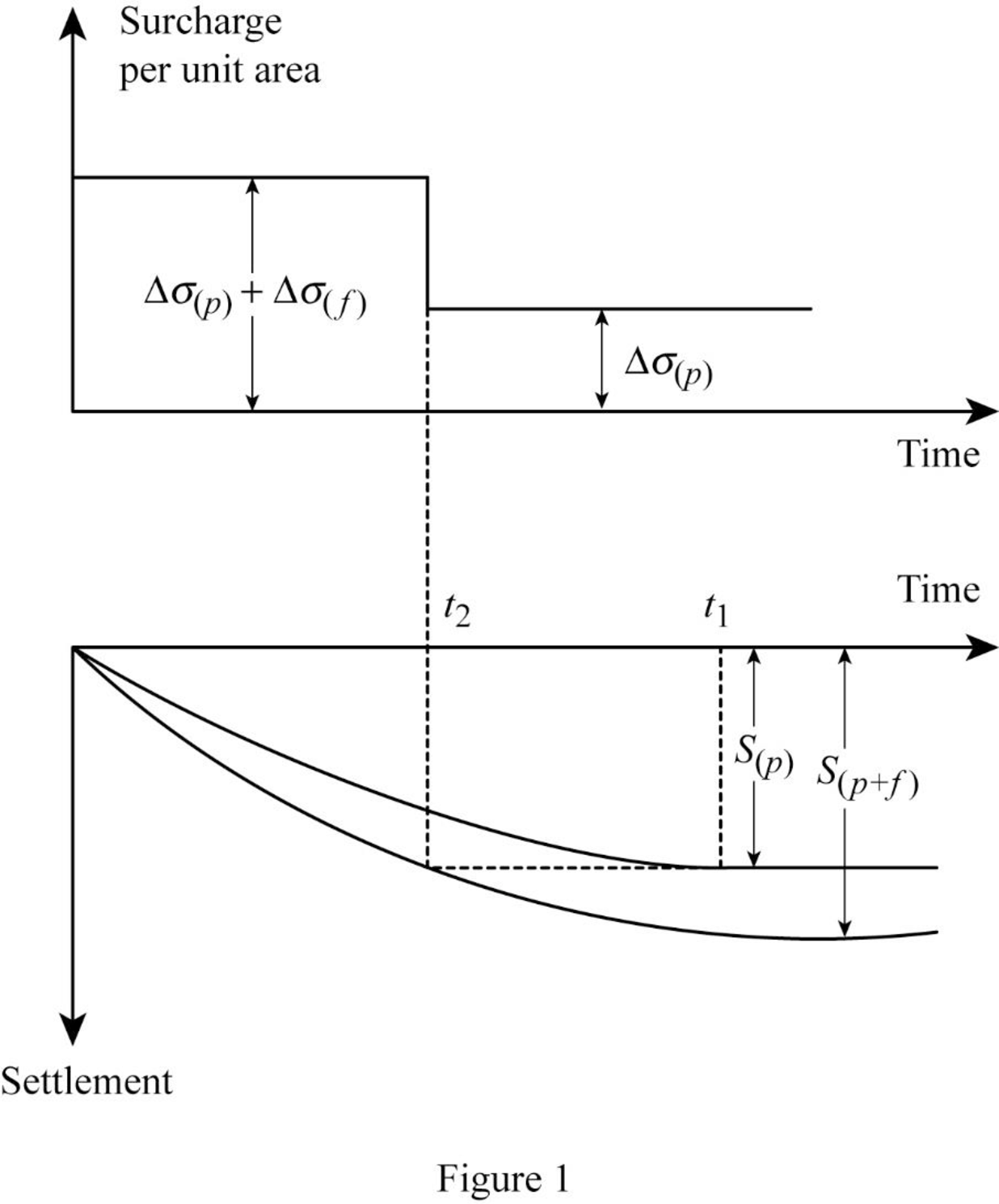
(a)
State whether the statement “addition of lime to clays increases the plasticity” is true or false.
(a)
Answer to Problem 11.1P
The given statement is
Explanation of Solution
Flocculation‑agglomeration is a chemical reaction that occurs when the lime is added to clayey soils and this reaction makes a texture change in the clay soil. In this process, the clay particle clumps together and forms larger particles due to the presence of lime resulting in plasticity reduction.
Therefore, the given statement is
(b)
State whether the statement “fly ash is pozzalanic” is true or false.
(b)
Answer to Problem 11.1P
The given statement is
Explanation of Solution
Fly ash is a by-product of pulverized coal and is extracted from flue gases through Electrostatic precipitator in dry form. Fly ash is a fine material and possesses good pozzalanic property.
Therefore, the given statement is
(c)
State whether the statement “vibrofoltation is more effective on clays than sands” is true or false.
(c)
Answer to Problem 11.1P
The given statement is
Explanation of Solution
Vibrofoltation is a construction technique used for the densification of thick layers of loose soils.
Refer Figure 11.3, “Effective range of grain-size distribution of soil for vibration” to identify the grain size in which vibrofloation is effective.
Vibrofoltation is effective for gravel, with 0% to 100% fines and with a grain size of 10 mm to 100 mm.
For coarse and fine sand, with a grain size of 0.1 mm to 10 mm and with 0% to 100% fines, vibrofoltation is effective.
For silts and clay, vibrofoltation is effective for clays with 0% to 40% fines and with a grain size of 0.1 mm to 0.001 mm.
Thus, vibrofoltation is more effective on sands than clays.
Therefore, the given statement is
(d)
State whether the statement “pre-compression is mostly applied on normally consolidated clays” is true or false.
(d)
Answer to Problem 11.1P
The given statement is
Explanation of Solution
Normally consolidation clays (NCC) are highly compressible. Thus, large constructions over the layer of NCC soils result in large consolidation settlement.
Pre-compression is applied on NCC to prevent the post consolidation settlement.
Ordinary soils generally are not highly compressive and thus less post consolidation settlement.
Thus, pre-compression are mostly applied on NCC.
Therefore, the given statement is
(e)
State whether the statement “duration of pre-compression is shorter, when the surcharge is larger in pre-compression” is true or false.
(e)
Answer to Problem 11.1P
The given statement is
Explanation of Solution
Show the pre-compression on normally consolidated clay due to structural load

Figure 1 shows the settlement-time relationship under the surcharge load of
The settlement,
The settlement of the clay layer rises with increase in time in both the cases (settlement due to structural load and surcharge load). Thus, the surcharge increases with the increase in the settlement with respect to time.
Therefore, the given statement is
Want to see more full solutions like this?
Chapter 11 Solutions
Fundamentals of Geotechnical Engineering (MindTap Course List)
- Please don't explain it. But draw it out for me kindly. And appreciate your time!. All the info is in the images. Thanks!.arrow_forwardDesign a simply supported one-way pavement slab for a factored applied moment, Mu = 10 ft-kip. Use f c’ = 5,000 psi and f y = 60,000 psi. The slab is in permanent contact with soil.Hint:• Estimate a minimum slab thickness for deflection control.• Solve for the slab steel based on cover for soil contactarrow_forwardThe figures below shows the framing plan and section of a reinforced concrete floor system. Floor beams are shown as dotted lines. The weight of the ceiling and floor finishing is 6 psf, that of the mechanical and electrical systems is 7 psf, and the weight of the partitions is 180 psf. The floor live load is 105 psf. The 7 in. thick slab exterior bay (S-1) is reinforced with #5 rebars @ 10 in. o.c. as the main positive reinforcement at the mid span, and #4 @ 109 in. for the shrinkage and temperature reinforcement. The panel is simply supported on the exterior edge and monolithic with the beam at the interior edge. Check the adequacy of the slab. Use the ACI moment coefficients. fc’ = 6,000 psi and fy = 60,000 psi. The slab is in an interior location. Hint: • Estimate total dead load. Find factored maximum positive bending moment in the end span. • Find design positive moment capacity. • Compare and determine adequacy, including safety and economy.arrow_forward
- 1 For an reinforced concrete two-way slab shown in figure under the load (P). (the slab continuous over all edges - all sides are fixed), Determine (By using yield line theory): A- Draw the Yield line Pattern B- Determine the moment m C- Find The required flexural steel to resist the loads causing the slab to collapse if P = 200 KN, f=28 MPa, fy = 420 MPa d = 120 mm. Use 10 mm bars. (Prin = 0.002) +2 m 6 m -8 m 3 marrow_forwardAt a point on the surface of a generator shaft the stresses are σx = -55MPa, σy = 25MPa and Txy = -20MPa as shown in Figure Q1. (a) Using either analytical method or Mohr's circle determine the following: Stresses acting on an element inclined at an angle 0 = 35°, i. ii. iii. The maximum shear stress The principal stresses and B. 25 MPa A 55 MPa 20 MPa Figure 1:Material stress state (b) Consider that the Young's modulus for the material, E = 200kPa and Poisson's ratio, v = 0.25. i. ii. determine associate strains for the material with the stress as shown in Figure 1 determine associate strains for the material with the stress at element oriented at 35° (question 1a(i))arrow_forwardA study reports data on the effects of the drug tamoxifen on change in the level of cortisol-binding globulin (CBG) of patients during treatment. With age = x and ACBG = y, summary values are n = 26, Σx, = 1612, Σ(x, - x)² = 3756.96, Σy, = 281.9, Σ(y, - y)² = 465.34, and Ex,y,= 16,745. (a) Compute a 90% CI for the true correlation coefficient p. (Round your answers to four decimal places.) (b) Test Hop=-0.5 versus H: p< -0.5 at level 0.05. Calculate the test statistic and determine the P-value. (Round your test statistic to two decimal places and your P-value to four decimal places.) z = P-value = State the conclusion in the problem context. ◇ Reject Ho. There is no evidence that p < -0.5. ○ Fail to reject Ho. There is evidence that p < -0.5. Reject Ho. There is evidence that p < -0.5. Fail to reject Ho. There is no evidence that p < -0.5. (c) In a regression analysis of y on x, what proportion of variation in change of cortisol-binding globulin level could be explained by variation in…arrow_forward
- For the frame and loading shown, determine the reactions at A and C. 24 Last 2 student ID+50 lbs 24 A 3 in. B A=Last 2 student ID+10 Inch B=Last 2 student ID+40 Inch A B Darrow_forwardThe figures below shows the framing plan and section of a reinforced concrete floor system. Floor beams are shown as dotted lines. The weight of the ceiling and floor finishing is 6 psf, that of the mechanical and electrical systems is 7 psf, and the weight of the partitions is 180 psf. The floor live load is 105 psf. The 7 in. thick slab exterior bay (S-1) is reinforced with #5 rebars @ 10 in. o.c. as the main positive reinforcement at the mid span, and #4 @ 109 in. for the shrinkage and temperature reinforcement. The panel is simply supported on the exterior edge and monolithic with the beam at the interior edge. Check the adequacy of the slab. Use the ACI moment coefficients. fc’ = 6,000 psi and fy = 60,000 psi. The slab is in an interior location. Hint: • Estimate total dead load. Find factored maximum positive bending moment in the end span. • Find design positive moment capacity. • Compare and determine adequacy, including safety and economy. C Darrow_forwardFor an reinforced concrete two-way slab shown in figure under the load (P). (the slab continuous over all edges - all sides are fixed), Determine (By using yield line theory): A- Draw the Yield line Pattern B- Determine the moment m C- Find The required flexural steel to resist the loads causing the slab to collapse if P = 200 KN, f=28 MPa, fy = 420 MPa d = 120 mm. Use 10 mm bars. Draw the yield line and (Qmin = 0.002) 2m solve PO 6 m 3 m -8 marrow_forward
- Find the internal torques for segments AB, BC, and CD (in N-m) by drawing the internal torque diagram, the maximum torsional shear on the shaft in MPa, and the relative rotation of section A with respect to section D in degrees.arrow_forwardFor an reinforced concrete two-way slab shown in figure under the load (P). (the slab continuous over all edges - all sides are fixed), Solve by using equilibrium method A- Draw the Yield line Pattern B- Determine the moment m C- Find The required flexural steel to resist the loads causing the slab to collapse if P = 200 kN, f=28 MPa, fy = 420 MPa d = 120 mm. Use 10 mm bars. (Pmin = 0.002) 2 m 6 m -8 m 3 marrow_forwardA double-T simply supported concrete beam its cross section is shown in Figure, is prestressed with 2 tendons each 400 mm². Determine the allowable service load. Use span 12 m, fse = 1300 MPa, fe = 40 MPa, y = 25 kN/m³. = 1200 mm >09 *100* As = 400 +100+ As = 400 400 1400+arrow_forward
 Fundamentals of Geotechnical Engineering (MindTap...Civil EngineeringISBN:9781305635180Author:Braja M. Das, Nagaratnam SivakuganPublisher:Cengage Learning
Fundamentals of Geotechnical Engineering (MindTap...Civil EngineeringISBN:9781305635180Author:Braja M. Das, Nagaratnam SivakuganPublisher:Cengage Learning Principles of Geotechnical Engineering (MindTap C...Civil EngineeringISBN:9781305970939Author:Braja M. Das, Khaled SobhanPublisher:Cengage Learning
Principles of Geotechnical Engineering (MindTap C...Civil EngineeringISBN:9781305970939Author:Braja M. Das, Khaled SobhanPublisher:Cengage Learning Construction Materials, Methods and Techniques (M...Civil EngineeringISBN:9781305086272Author:William P. Spence, Eva KultermannPublisher:Cengage Learning
Construction Materials, Methods and Techniques (M...Civil EngineeringISBN:9781305086272Author:William P. Spence, Eva KultermannPublisher:Cengage Learning Principles of Foundation Engineering (MindTap Cou...Civil EngineeringISBN:9781337705028Author:Braja M. Das, Nagaratnam SivakuganPublisher:Cengage Learning
Principles of Foundation Engineering (MindTap Cou...Civil EngineeringISBN:9781337705028Author:Braja M. Das, Nagaratnam SivakuganPublisher:Cengage Learning Principles of Foundation Engineering (MindTap Cou...Civil EngineeringISBN:9781305081550Author:Braja M. DasPublisher:Cengage Learning
Principles of Foundation Engineering (MindTap Cou...Civil EngineeringISBN:9781305081550Author:Braja M. DasPublisher:Cengage Learning




